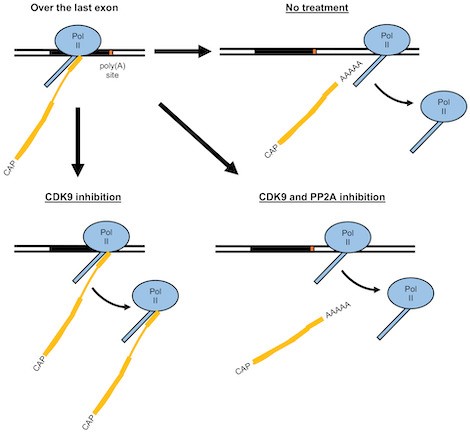CDK9 and PP2A coordinate to regulate transcription and RNA processing
Published in EMBO reports, a new paper from the Murphy group uncovers novel roles for CDK9 and PP2A in the regulation of transcription and RNA processing.
CDK9 is a kinase critical for RNA polymerase II transcription. Without it, RNA polymerase II either does not escape promoter regions or prematurely terminates. To study the function of CDK9 during transcription, Tellier et al. from the Murphy group used a chemical genetics approach, in which CDK9 is mutated to accept “bulky” ATP-analogs that rapidly inhibit kinase activity. Tellier et al. show that loss of CDK9 activity causes RNA polymerase II to prematurely terminate across the last exon of genes, resulting in the loss of polyadenylation of nascent transcripts. Interestingly, inhibition of the phosphatase PP2A counteracts the effects of CDK9 inhibition, demonstrating that the coordination of CDK9 and PP2A activities are key for proper regulation of RNA polymerase II transcription and co-transcriptional RNA processing in human cells.
Building on this publication, lead author of the study, Michael Tellier, has recently been offered a PI position at the University of Leicester. On his new position, Michael said: “I am really excited about this opportunity to start my own research group as it will allow me to investigate new research questions and to begin novel interdisciplinary collaborations. I will miss Shona’s lab and the Dunn School as the whole as I have been here for the past seven years. The scientific and human environment of Shona’s lab and of the Dunn School have been really important, especially from all the people I collaborated with, as it has allowed me to grow scientifically.“
Written by Isabella Maudlin (Murphy lab) @BellaMaudlin
Michael Tellier, Justyna Zaborowska, Jonathan Neve, Takayuki Nojima, Svenja Hester, Marjorie Fournier, Andre Furger, Shona Murphy (2022). CDK9 and PP2A regulate RNA polymerase II transcription termination and coupled RNA maturation. EMBO Reports, 23:e54520
